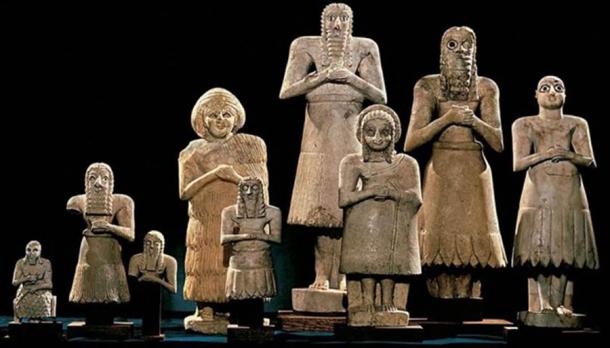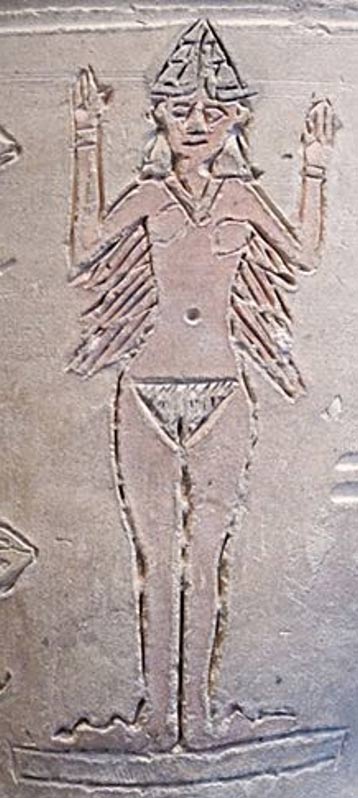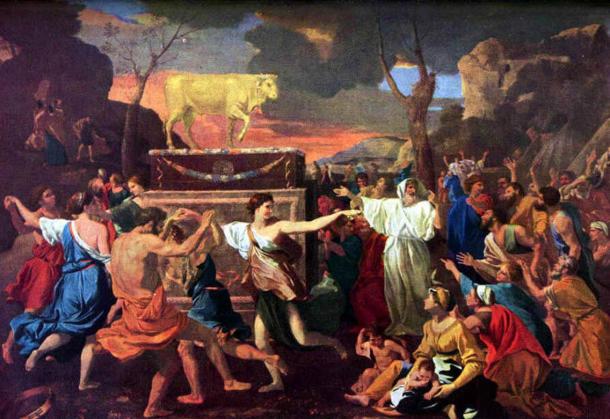The tale of our creation we know from the Bible is only half the story—one which has been heavily edited. But have you ever wondered how god created male and female in his image? There are other sources that give alternate accounts, filling in missing details or answering questions raised by reading Genesis. The Jews wrote their religious texts while in captivity in Babylon, using the Sumerian and Assyrian tales of gods and goddesses as a basis, and then amending them to fit their own mythology and religion. It is in the Sumerian/Babylonian tales we find a different perspective on a well-known story.
The Anunnaki – A Different Version of a Well-Known Story
In ancient myth Enki and Enlil were known as two half-brothers fighting for control over Earth, with their father, Anu, undecided as to who should succeed him. Their half-sister was Sud, and she was held in the highest esteem by the Anunnaki, and had her own base of power on a sacred mountain, Eridu.

The Sumerian Pantheon. ( Fredsvenn)
It was said the tradition among the Anunnaki was to secure the bloodlines through mating half-siblings (never full-blooded siblings). So even if a male produced an heir with his concubine or wife, if he then had a son with his half-sister, that child would be the heir presumptive.
This was the base of the disagreement between Enki and Enlil, which we see replicated in the story of Abraham and his sons. Abraham had a child with Hagar, and their son Ishmael was the eldest and should have been the heir, but his wife Sarah was, according to some accounts, Abraham’s half-sister and so their son Isaac had precedence.
Whether it was to keep the family together and bring peace to the warring brothers, or because she had plans for her own descendants, Sud mated with both Enki and Enlil, producing heirs. The result was such that the next generation found themselves continuing the dispute and quite often Sud had to be called in to settle wars.
As a result of her peace efforts and in acknowledgement of her accomplishments as a scientist, including the creation of humans, she was given the honorific ‘Lady of Life’, or Mammu/Mama and became known from then on as Ninkharsag. She is the mother-goddess that we know in many forms, (though not Mother-Earth, which is Tiamat or Gaia), the creator of life whose milk nourishes kings.

Akkadian cylinder seal impression depicting a vegetation goddess, possibly Ninhursag, sitting on a throne surrounded by worshippers (circa 2350-2150 BC). ( Public Domain )
Ninkharsag and the Creation of Humanity
As far as we know, legend indicates her motives in creating humans were unselfish. The Anunnaki wanted servants to do the menial tasks for them on Earth and so it fell to Ninkharsag and Enki to create these beings. After some time, Enki was not satisfied with their creation who “ate out of troughs like sheep” and wanted to give them more intelligence. Ninkharsag agreed and their experiments were eventually successful, though Enlil was outraged at what they had done, accusing them of making men “like Gods.”
While Ninkharsag’s motives were said to have been for the best —seeking to better the lives of their servants and give them intelligence with the hope they may have fulfilling lies—Enki was a little more complicated.
He needed soldiers, and in the texts, he and one of his sons outfitted and trained humans to wage war , which implies this is the fundamental reason for mankind’s willingness to war on behalf of ‘God’; it was supposedly ingrained into our ancestors at the moment of their awakening. It is apparent that though Enki may have bred soldiers, he was preferable as Earth’s ruler from humanity’s point of view, than his harsh and tyrannical brother.
As a result of the back and forth between the two brothers, Ninkharsag found herself siding with Enki more and more, and despising Enlil’s treatment of the humans, whom she loved. Every time they suffered, either as a result of war or natural disaster, she would weep as though for her own children.
The Goddess Loses Her Position
So, how did she lose her position? The mythological record states the war of arms became a war of ideology as mankind continued to grow in spite of Enlil’s efforts at population control. As man diversified, most found themselves in two camps: Enki, whose dominion was Magan, or Egypt, and Enlil, who had moved his power base from Sumer to what we know today as Jerusalem. All three were old by that time, and Ninkharsag was mockingly being referred to as “an old cow” behind her back by the other Anunnaki, though she still had power.
Enlil, however, felt himself betrayed—by his brother Enki not accepting his claim to the throne, and by Ninkharsag taking his side. Also he felt deceived by their creation of intelligent humans starting with Eve, and by Innana (often mistaken for Ninkharsag, but a different female), who ransacked his ‘Holy of Hollies’ in her quest to dominate the earth.

Inanna, the most prominent female deity in ancient Mesopotamia on the Ishtar Vase. ( Public Domain )
We get the sense that Enlil becomes embittered by these setbacks and that this anger passes to his sons and grandsons, and the ideas spread, even to some of Enki’s sons. It was this, through an amalgamation of the different Sumerian Gods, that the figure of Yahweh is said to have come into being—one whose followers proclaimed that he wanted supremacy over all, declaring that man should have no other gods but him, and decreeing the others to be “demons”.
Though ancient texts say Enki was figuratively cast out of the Pantheon as the serpent, and Eve and Lillith demonized for their demonstration of will, it was still difficult for the priesthood to supplant Ninkharsag, who had become the middle-eastern Asherah ( Astarte), the partner of El.

Called ‘Lady of Galera.’ Phoenician figure representing an ancient Mideastern deity, probably the goddess Astarte. (Luis Garcia/ CC BY 3.0 )
In many places in the Old Testament, there were prophets begging the people to forget Asherah, and threatening god’s wrath and punishment for disobedience. Yet worship of the Mother was ingrained in them.
For example, the book of Jasher (who was the personal staff-bearer to Moses) which tells us the story of the Exodus, but from a different perspective, says that it was not Moses, but Miriam who was the spiritual leader of the tribes. At that point the Jews did not worship Jehovah, but Asherah, who was symbolized as a golden cow.
It was a struggle for Moses to wean his people away from the worship of Asherah and he had to resort to imprisoning Miriam, yet it still took hundreds of years during which time Yahweh and Asherah were worshipped together, before the priests were able to stop the worship of the goddess.

The Adoration of the Golden Calf. (1633) ( Public Domain )
It was not until their captivity in Babylon that the followers of Yahweh, who despised the influence of Asherah, took advantage of the vast libraries and texts to create their own religious texts—rewriting their history in the process. ‘God’ became a single being, creating man and woman in ‘his’ image.
What happened to Ninkharsag/Asherah? She could not be completely erased, so they rendered her ethereal, inconsequential. She was acknowledged as holy, yet held no personality, no voice, no force of will, or identity. In the end she became, literally, a ghost.
Top Image: Detail of Painting ‘Astarte Syriaca.’ (1881) Source: Public Domain
Updated on May 13, 2021.
 RSS Feed
RSS Feed















 May 13th, 2021
May 13th, 2021  Awake Goy
Awake Goy  Posted in
Posted in  Tags:
Tags: 













